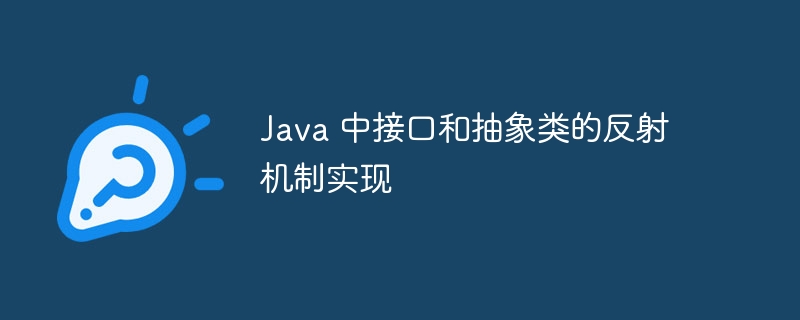
The reflection mechanism allows the program to obtain and modify class information at runtime. It can be used to implement reflection of interfaces and abstract classes: Interface reflection: Obtain the interface reflection object through Class.forName() and access its metadata (name, method and fields). Reflection of abstract classes: Similar to interfaces, you can obtain the reflection object of an abstract class and access its metadata and non-abstract methods. Practical case: The reflection mechanism can be used to implement dynamic proxies, intercepting calls to interface methods at runtime by dynamically creating proxy classes.

Implementation of interface and abstract class reflection mechanism in Java
The reflection mechanism is a feature of the Java programming language that allows programs Obtain and modify class information at runtime. It can be used to implement reflection of interfaces and abstract classes.
Reflection of interface
To obtain the reflection object of the interface, you can use Class.forName() method:
Class<?> interfaceClass = Class.forName("com.example.MyInterface");Through the reflection object of the interface, you can access the metadata of the interface, such as names, methods and fields:
System.out.println("Interface name: " + interfaceClass.getName());
// 获取接口的所有方法
Method[] methods = interfaceClass.getMethods();
for (Method method : methods) {
System.out.println("Interface method: " + method.getName());
}Reflection of abstract classes
Similar to interfaces, you can also use Class.forName() Method to obtain the reflection object of the abstract class:
Class<?> abstractClass = Class.forName("com.example.MyAbstractClass");For an abstract class, you can access its metadata and non-abstract methods:
System.out.println("Abstract class name: " + abstractClass.getName());
// 获取抽象类的所有方法
Method[] methods = abstractClass.getMethods();
for (Method method : methods) {
if (!method.isAbstract()) {
System.out.println("Non-abstract method in abstract class: " + method.getName());
}
}Practical case: dynamic proxy
The reflection mechanism can be used to implement dynamic proxy. This pattern allows creating a proxy for a class at runtime without having to define the class beforehand:
// 为 MyInterface 创建一个动态代理 InvocationHandler handler = new MyInvocationHandler(); Class<?> proxyClass = Proxy.getProxyClass(interfaceClass, handler); MyInterface proxy = (MyInterface) proxyClass.newInstance(); // 使用代理调用接口方法 proxy.someMethod();
In MyInvocationHandler we can implement invoke()## as needed # Method to intercept calls to interface methods.
The above is the detailed content of Reflection mechanism implementation of interfaces and abstract classes in Java. For more information, please follow other related articles on the PHP Chinese website!
